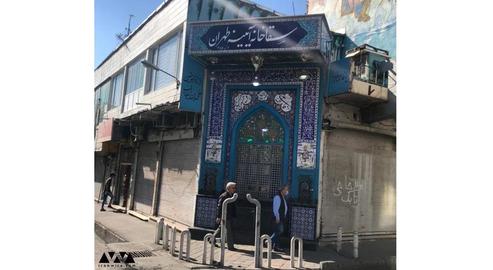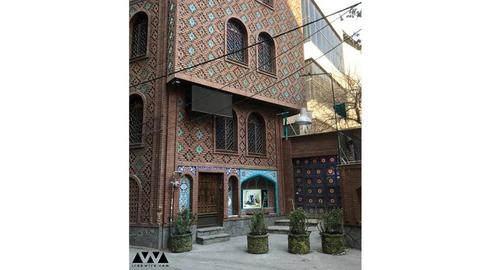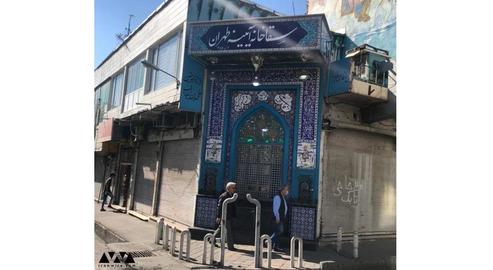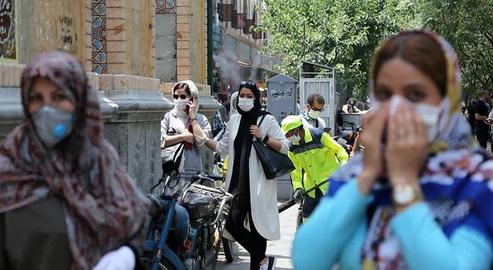Saqakhanehs are among the shining examples of classic and nostalgic architecture in various cities of Iran. They provide free water to thirsty passers-by and are particularly revered by Shiites. In the capital city of Tehran, several saqakhanehs are still standing today. The "Mirror of Tehran" on Zahir al-Dowleh Street, itself one of the oldest streets in Tehran, is one of them.
***
An old steel window with stained glass, a place for people to tie their dakhil [tributes tied in a knot to a shrine] and vows, two places to light candles, and two ancient taps, make up the Mirror of Tehran saqakhaneh in Zahir al-Dowleh Street.
The old, mirrored tiles, from which the saqakhaneh takes its name, are inscribed with prayers and the names of the Shiite Imams. This old structure is located right between two shops in one of the oldest streets in the south of Tehran.
Saqakhanehs have existed for many years to provide water to passers-by. Since they were first build, they have become sacred places for Shias, where candles are lit and vows, dakhils and prayers are offered.
"Hydration is revered among Shiites, deriving from the Karbala incident," says Farzad, a social affairs researcher who studies the relationship between culture and historical sites. “As a result, over time, these centers became sacred. According to the Shiite narration of the Karbala incident, enemy troops blocked water from reaching Hossein's army, the third Imam of the Shiites, and they fought with thirsty lips and attained ‘martyrdom’.”
Tehran Mirror is currently running dry due to the outbreak of coronavirus. But Somayeh, a resident of the neighborhood, says that in the past people drank their fill at this place, praying under their breath and expressing their vows and needs: "In a way, they believed that this water was blessed and would grant their wishes."
Farzad confirms this, and adds: "In fact, saqakhaneh is a kind of water vow, and in Shiite culture it is always a blessed one that responds to your needs.
"Some of these saqakhanehs were temporary, and were established only during the days of Moharram. But others, with the name of the benefactor and its founder usually written on a corner of the structure, were permanent. Its original base was a vessel full of water and a few small golden bowls engraved with the names of the Imams inside them, which were then chained to the vessel, and people drank water from them with the intention of healing."
Somayeh says that until a decade or so ago, many people drank regularly from the same bowls at the saqakhaneh. "Of course, in the last 15 or 20 years, public culture has changed a lot, and many people, even if they do drink water from these places, now drink from their own glasses.”
She believes that saqakhanehs are historical relics that are now obsolete, and what remains is not the old form. "Many saqakhanehs were destroyed. Those that remain have remained as souvenirs; their function is different."
Farzad says the role of the saqakhanehs, like all other urban phenomena, has evolved over time. Their creators either left the neighborhoods or died, and many of the structures were no longer cared for. Private properties have often sprung up right alongside them, and many have disappeared into the surrounding cityscape.
Somayeh says the spread of coronavirus and people's fear of Covid-19 has meant to-one is so much as lighting a candle or praying near the Mirror of Tehran now. "Tasua and Ashura are the busy times; normally everyone comes and lights candles here during this period. But now everyone is afraid of getting sick."
The exterior of the Imam Hassan Cultural Center in the Dibaji neighborhood of Tehran has also been built in the shape of a saqakhaneh. There is similarly a place to light candles and drink water, but the building is almost new, achingly stylish and different to the old saqakhaneh structures. In essence, it looks like a modern saqakhaneh.
Mansoureh, an architecture student and researcher of ancient buildings in Iran, says: "In traditional Iranian architecture, the saqakhanehs were small structures to fetch water from the walls in urban passageways, and were decorated according to the style of the day. They were tiled or had metal carvings. Over time, the saqakhanehs became larger, and the prayers and icons of the Shiite imams were added to their decorations."
She says that one of the most beautiful saqakhanehs she has ever seen is the Abolfazl saqakhaneh in Ardabil, which is located next to the tomb of Sheikh Safi al-Din Ardabili: "This saqakhaneh, which is said to have been built during the Qajar dynasty, combines beautiful Iranian and Islamic architecture and is one of the most important historical and religious sites for the people of Ardabil. All religious ceremonies of Muharram begin next to this place, and for the residents of Ardabil, this is one of the holiest places."
She speculates that the Abolfazl Saqakhaneh will no longer have the atmosphere of the past: "The spread of the coronavirus must have taken away some of its glory."
This article was written by a citizen journalist in Tehran under a pseudonym.
visit the accountability section
In this section of Iran Wire, you can contact the officials and launch your campaign for various problems



























comments